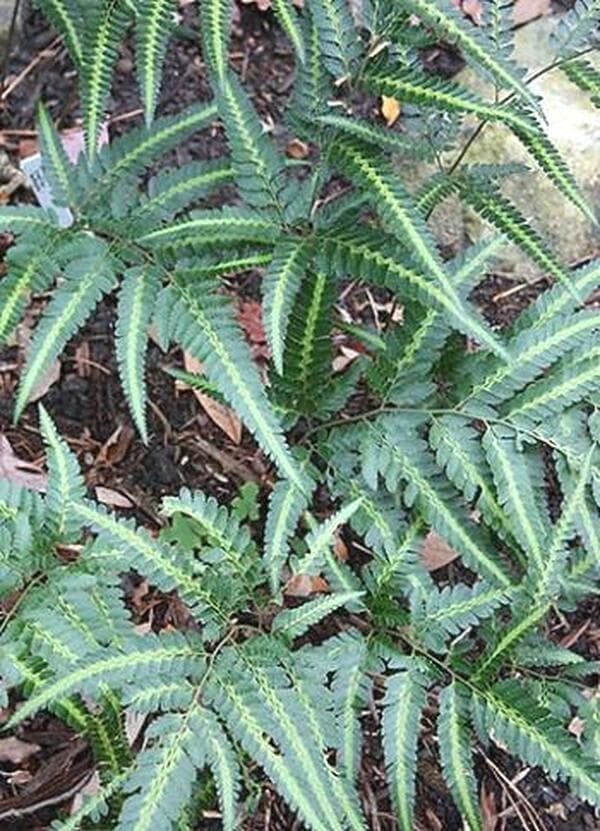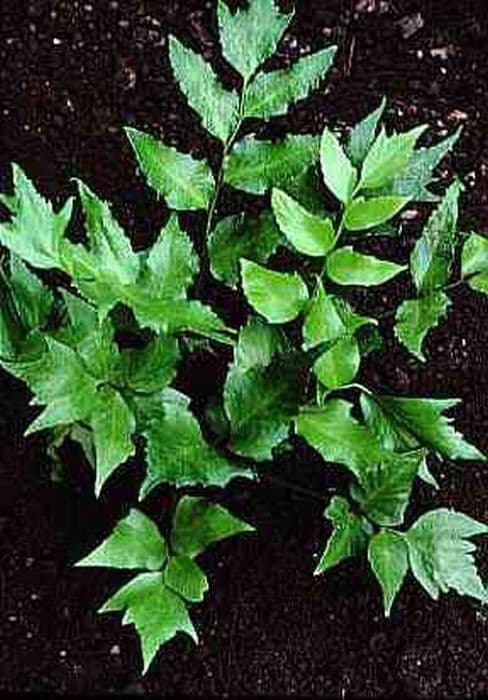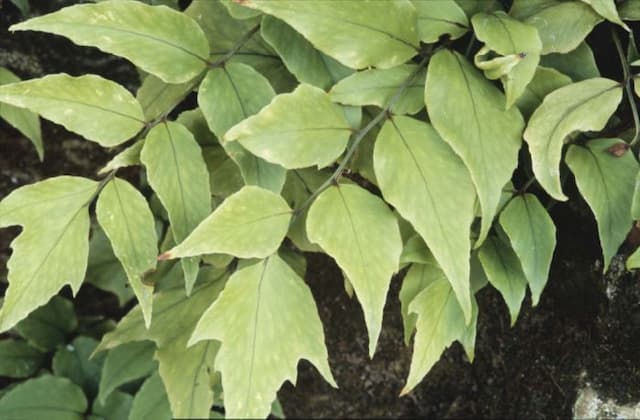Alpine wood fern Dryopteris wallichiana











ABOUT
Dryopteris wallichiana, commonly known as the Alpine wood fern, is a robust and attractive fern that is known for its lush and arching fronds. The plant exhibits a classic fern appearance with a central, erect rhizome from which the fronds radiate. The fronds of the Alpine wood fern are pinnate, which means that they are divided into leaflets arranged on either side of a common axis. These leaflets are further subdivided into smaller leaf segments, giving the fronds a delicate, feathery texture. The Alpine wood fern is notable for its glossy green color, which shines in the light and adds a vibrant, verdant quality to its surroundings. The stems, also referred to as stipes, are characteristically scaly and can exhibit a contrast in color compared to the green of the fronds. The scales are often a darker hue, ranging from brown to almost black, and are an identifying feature of the plant. Young fronds unroll from a coiled position, a process known as "circinate vernation," which is typical of many fern species. These emerging fronds, sometimes referred to as "fiddleheads," present a coiled, spiral form before unfurling into full, flat fronds. Though the size of the plant is not under discussion, it is worth noting that the mature form of the Alpine wood fern produces a symmetrical, shuttlecock-like shape that can be quite striking in a woodland garden or shade garden setting. The overall texture of the fern is lush and dense, making it a substantial presence wherever it grows. The fronds persist for some time, and their arrangement creates a layered, dimensional aspect to the plant, with the newest growth emerging from the center and older fronds arching outward. Over time, a well-established Alpine wood fern can form a substantial clump due to its growth habit. This plant, with its quintessential fern characteristics, is both a popular and aesthetically pleasing choice for fern enthusiasts and gardeners looking to add a touch of tranquility and natural woodsy beauty to their landscape.
About this plant
 Names
NamesFamily
Dryopteridaceae
Synonyms
Wallich's Wood Fern, Alpine Wood Fern, Wallich's Fern
Common names
Aspidium wallichianum, Nephrodium wallichianum, Dryopteris assimilis, Dryopteris pseudo-mas, Lastrea wallichiana, Thelypteris wallichiana.
 Toxicity
ToxicityTo humans
The plant Dryopteris wallichiana, more commonly known as the Alpine wood fern, is not known to be highly toxic to humans. However, as with many ferns and other plants, it should not be ingested as it could potentially cause mild stomach upset due to the presence of various plant compounds that could be irritants. There is no widely recognized significant toxic effect from ingestion of this fern to humans, and any accidental ingestion would likely result in no more than mild gastrointestinal discomfort.
To pets
The Alpine wood fern is not known to be toxic to pets. It does not contain any known compounds that are considered highly poisonous to common household pets such as dogs and cats. However, ingestion of any non-food plant material can potentially lead to mild gastrointestinal upset in pets. It is always a good practice to prevent pets from ingesting plants, as individual animals may have unique sensitivities and the ingestion of plant matter can lead to vomiting or diarrhea.
 Characteristics
CharacteristicsLife cycle
Perennials
Foliage type
Evergreen
Color of leaves
Green
Height
3 feet (91 cm)
Spread
3 feet (91 cm)
Plant type
Fern
Hardiness zones
6
Native area
Himalayas
Benefits
 General Benefits
General Benefits- Ornamental Appeal: Dryopteris wallichiana, commonly known as Alpine wood fern, offers aesthetic enhancement to gardens with its lush greenery and feathery fronds.
- Shade Tolerant: This fern thrives in shaded areas, making it ideal for planting under larger trees or in shadowy parts of the garden.
- Soil Erosion Control: The robust root system of Alpine wood fern helps to stabilize soil and prevent erosion, especially in sloped gardens.
- Wildlife Habitat: It provides shelter and food for various insects and small animals, contributing to the biodiversity of the garden ecosystem.
- Low Maintenance: Alpine wood fern requires minimal care once established, making it a convenient choice for gardeners of all levels of experience.
- Drought Resistance: Once established, it can withstand periods of low water availability, useful in xeriscaping or areas with water restrictions.
- Cold Hardy: It is tolerant of cooler temperatures and can survive in temperate climates, which makes it a resilient choice for many gardens.
- Companion Planting: Alpine wood fern complements other shade-loving plants, and can be used effectively in mixed plantings for an attractive underplanting effect.
 Medical Properties
Medical Properties- Antihelminthic: Dryopteris wallichiana has been used in traditional medicine to expel parasitic worms (helminths).
- Anti-inflammatory: There is some traditional use of the plant for its anti-inflammatory properties.
- Astringent: The plant has been used for its astringent properties, thought to help in wound healing.
 Air-purifying Qualities
Air-purifying QualitiesThis plant is not specifically known for air purifying qualities.
 Other Uses
Other Uses- Horticultural Display: Dryopteris wallichiana, commonly known as Alpine wood fern, is often used as an ornamental plant in gardens due to its attractive fronds and robust growth.
- Shade Tolerance: As a shade-loving plant, the Alpine wood fern is ideal for planting under the canopies of larger trees or in shady corners of the garden where other plants may struggle to thrive.
- Soil Erosion Control: The dense root system of the Alpine wood fern can help stabilize soil and prevent erosion on slopes or in areas with loose soil.
- Garden Borders: The defined shape and size of Alpine wood fern make it suitable for use as a natural border or edge in landscaping designs.
- Winter Garden Interest: With semi-evergreen or evergreen varieties, the Alpine wood fern can add greenery and textural interest to winter gardens in milder climates.
- Companion Planting: Alpine wood fern can be planted alongside other shade-loving perennials and ferns to create a lush, woodland garden effect.
- Ground Cover: When planted in groups, the ferns can act as a living mulch, covering the ground and minimizing weed growth.
- Texture Contrast: Its feathery fronds can provide a striking textural contrast when planted next to plants with broad or glossy leaves.
- Wildlife Shelter: The dense foliage can offer shelter and breeding grounds for various insects, small mammals, and amphibians.
- Education and Conservation: Alpine wood fern is sometimes used in educational settings such as botanical gardens to teach about fern life cycles and conservation of native plant species.
Interesting Facts
 Feng Shui
Feng ShuiThe Alpine Wood Fern is not used in Feng Shui practice.
 Zodiac Sign Compitability
Zodiac Sign CompitabilityThe Alpine Wood Fern is not used in astrology practice.
 Plant Symbolism
Plant Symbolism- Endurance: Dryopteris wallichiana, commonly known as the Alpine Wood Fern, can thrive in challenging environments, often symbolizing one's ability to endure difficult conditions.
- Protection: Historically, ferns have been regarded as plants that offer shelter and protection, and the Alpine Wood Fern is no exception, implying a safeguarding aspect.
- Secretiveness: Ferns in general carry a mystical quality, with their lush fronds often related to secretiveness or concealment, and the Alpine Wood Fern shares this symbolism.
- Fertility: The prolific spread and growth of ferns can denote fertility or new growth, which applies to the Alpine Wood Fern as well.
 Water
WaterThe Alpine Wood Fern should be watered thoroughly and consistently, but not so much as to soak or waterlog the soil. Aim to water the plant once a week, allowing the top inch of soil to dry out between waterings. When you water, do so deeply, using approximately one to two gallons of water depending on the size of the plant and the pot. During the winter months, reduce the frequency of watering since the plant’s growth slows down and it requires less moisture.
 Light
LightThe Alpine Wood Fern thrives best in partial to full shade conditions. It should be positioned in a spot where it can receive dappled sunlight or only brief periods of morning sun, avoiding direct afternoon sun which can scorch its delicate fronds. An ideal indoor location would be North or East-facing windows or a shaded West or South-facing window.
 Temperature
TemperatureThe Alpine Wood Fern does best in cool to moderate temperatures, ideally between 60 to 70 degrees Fahrenheit. It can survive minimum temperatures down to 55 degrees Fahrenheit and maximum temperatures up to 75 degrees Fahrenheit, with the cooler end of this spectrum preferred.
 Pruning
PruningThe Alpine Wood Fern benefits from occasional pruning to remove dead or damaged fronds and to maintain its attractive shape. Prune in the spring, just before the new growth starts. This is typically done annually, and sporadic removal of any unsightly fronds can be performed as needed throughout the year.
 Cleaning
CleaningAs needed
 Soil
SoilAlpine Wood Fern thrives in loose, rich organic soil with good drainage. A mixture composed of equal parts loam, peat, and sand works well, maintaining slight acidity with a pH of 5.5 to 6.5.
 Repotting
RepottingAlpine Wood Fern should generally be repotted every 2 to 3 years to refresh the soil and accommodate its growing root system.
 Humidity & Misting
Humidity & MistingAlpine Wood Fern prefers high humidity levels, ideally above 60%, to thrive.
 Suitable locations
Suitable locationsIndoor
Place Alpine Wood Fern in bright, indirect light with high humidity indoors.
Outdoor
Plant Alpine Wood Fern in shaded areas with moist, rich soil outdoors.
Hardiness zone
5-8 USDA
 Life cycle
Life cycleDryopteris wallichiana, commonly known as Alpine wood fern, begins its life as a spore released from mature fern fronds. These spores germinate in moist environments to produce a gametophyte, a small heart-shaped autotrophic plant that bears both male and female reproductive organs. Fertilization occurs when water allows sperm to swim to an egg, resulting in a zygote that will develop into a new sporophyte, the typical fern plant. The sporophyte emerges as a fiddlehead, which unfurls into a mature fern with fronds that are capable of photosynthesis. Over time, these fronds produce clusters of spores on their undersides, completing the reproductive cycle. The plant continues to grow larger with each season, with the fronds eventually dying back in the winter and new growth emerging in the spring.
 Propogation
PropogationPropogation time
Spring-Summer
The Alpine wood fern, Dryopteris wallichiana, is typically propagated by spores, which are generally collected in late summer when they are ripe. To propagate by spores, one must first collect the spore-laden fronds and dry them to release the spores. These are then sown on the surface of a sterilized, moist potting mix. The container is then sealed with a plastic cover to maintain humidity and placed in indirect light. It can take weeks to months for spores to germinate and they require meticulous attention to avoid fungal infections. Once the spores develop into small ferns, they can be transplanted into individual pots. This process, while not complicated, does require patience and a controlled environment to increase the chances of successful propagation.









